
方案详情
文
New and practical acid-promoted domino bicyclization between 2,2-dihydroxyindene-1,3-dione and cyclic enaminones has been established for the formation of tetracyclic isochromeno[4,3-b]indoles under microwave heating. The present method simultaneously installs CeN, CeO, and CeC bonds, allowing direct assemble of functionalized isochromeno[4,3-b]indole skeleton with a wide diversity in substituents. The reaction features reliable scalability, flexibility of structural modification, and wide substrate scope as well as operational simplicity, and it can avoid time-consuming and costly syntheses, tedious work-up, and isolation of intermediate.
方案详情

耐士科技400-188-0725www.rysstech.comTetrahedron 70 (2014)9628-9634 www.rysstech.comF-J. Zhao et al./Tetrahedron 70 (2014) 9628-9634耐士科技400-188-07259629 Contents lists available at ScienceDirect Tetrahedron ELSEVIER journal homepa ge:www.elsevier.com/locate/tet Domino bicyclization of 2,2-dihydroxyindene-1,3-dione with cyclicenaminones leading to isochromeno[4,3-b]indoles Fu-Jie Zhao, Mu-Yan Sun , Yi-Jing Dang , Xiao-Yan Meng, Bo Jiang *, Wen-Juan Hao,Shu-Jiang Tu* School of Chemistry and Chemical Engineering, Jiangsu Key Laboratory of Green Synthetic Chemistry for Functional Materials, Jiangsu NormalUniversity, Xuzhou 221116, Jiangsu, PR China ARTICLEIN F O Article history:Received 15 September 2014Received in revised form 29 October 2014Accepted 3 November 2014Available online 6 November 2014 Keywords: 1. Introduction The structural range and biological importance of functionalisocoumarins has made them attractive research targets over thepast decades.12 Their derivatives areefound in various naturalproducts such as monocerin, bergenin, cephalosol, cytogenin, andfusarentin (Fig. 1), which have an appreciable chemical and bi-ological significance. They were found to possess widespread bi-ological activitiesincluding anti-inflammatory, antiallergic,antimicrobial,immunomodulatory,cytotoxicity,4 antifungal,anti-inflammatory,antiangiogenic, and antimalarial. Synthesisof functional isocoumarins occupied an important place in organicand medicinal research due to their unique and intriguing thera-peutic and pharmacological properties. Accordingly, significantefforts have been devoted to powerful and reliable access to iso-coumarin derivatives. Their metal-catalyzed variants have takena pivotal position, and a variety oftransition-metal complexes, suchas Rh,Pd,10 Ru, and Cu,12have been utilized. Moreover, Bulling-tonnand co-workersddeveloped thereactionof 2.2-dihydroxyindene-1,3-dionewithh electron-donatingaromaticamines for forming tetrahydroindeno[l,2-b]indolones, followed byrearrangement reactionl to give three examples of isochromeno ( * C orresponding authors. T el./fax: +86 516 83500065; e-mail addresses: j iang- chem@jsnu.edu.cn (B. Jiang), lao tu@jsnu.edu.cn (S.- J . Tu). T These authors are equal to this work. ) ( h tt p ://dx.doi.org/1 0 .1016/j.t e t.2014.11 . 0 05 ) 4,3-bjindol-5(11H)-one.13However, this synthetic procedureremained several limitations involving limited substrate scope, andmulti-step route, and poor total yields of products. Therefore, thedevelopment of a reliable and practical protocol for the direct for-mation of isochromeno[4,3-b]indole derivatives would be highlyfavorable. Domino reactions have emerged as a powerful tool in organicand medical research, allowing the formation of complex moleculararchitectures in a convergent manner. 4Due to their high efficiency,synthetic economy, and ecology in the construction of complexheterocyclic frameworks, Domino reactions have become a special Fig. 1. Some naturally occurring bioactive isocoumarins. and interesting research topic, enabling their rapid developmentover the past several decades.15 Recently, we have establisheda three-component reaction of 2,2-dihydroxyindene-1,3-dionewith aromatic amines and symmetrical dimethyl but-2-ynedioatein acetic anhydride for the formation of isochromeno[4,3-b]pyr-roles. Inspired by the above three-component reaction and ourrecent findings on the applicability of cyclic enaminones,17 weenvisioned that a domino strategy encompassing a ring expansionand an annulation reaction could pave the way to the collection ofisochromeno[4,3-b]indole derivatives. To the best of our knowl-edge, one-step synthesis of isochromeno[4,3-b]indoles from low-cost and readilyaccessible 2,2-dihydroxyindene-1,3-dione and cy-clic enaminones through bicyclization process has not been docu-mented so far. Herein, we would like to report this usefulbicyclization reaction (Scheme 1). 2. Results and discussion 2,2-Dihydroxyindene-1,3-dione is a useful building block, whichusually was used to synthesize important cyclic skeletons, becauseof it possessing three electrophilic sites. Our strategy for thesynthesis of highly functionalized isochromeno[4,3-b]indolesstarted from the reaction of 2,2-dihydroxyindene-1,3-dione 1 withcyclic enaminones 2, based on the fact that 2,2-dihydroxyindene-1,3-dione was subjected with cyclicenaminoneswith11,3-bisnucleophilic centers, allowing thee formation ofdihydrox-yindenes and the following rearrangement in an appropriate acidicmedia to give the desired products 3.13,16' Based on the aboveanalysis, we initially focused on optimizing the reaction conditionsby treatment with 2,2-dihydroxyindene-1,3-dione 1 and 3-(4-fluorophenylamino)-5,5-dimethylcyclohex-2-enone 2a. The repre-sentative data were summarized in Table 1. The domino reaction of1 with 2a was carried out in Ac20 at 100 °C for 20 min, and theexpected isochromeno[4,3-b]indoles 3a was not observed at all.Instead, the functionalized indeno[1,2-b]indoles was obtained.8d Entry Solvent Promoter (equiv) T(°C) Yield(%) 1 Ac2Q 100 Trace 2 HOAc 100 40 3 HCO2H 100 32 4 TFA 100 Trace 5 HOAc p-TsOH (1.0) 100 58 6 HOAc TFA (1.0) 100 64 7 HOAc TFA (2.0) 100 75 8 HOAc TFA (3.0) 100 70 9 HOAc TFA(2.0) 80 62 10 HOAc TFA(2.0) 110 83 11 HOAc TFA (2.0) 120 82 The desired product 3a was provided in 40% chemical yield whenacetic acid (HOAc) was used as an acidic media at 100 °C undermicrowave irradiation. The use of HCO2H gave 32% yield of 3awhereas the reaction did not proceed in CF3C02H (TFA), and cyclicenaminones 2a did not be consumed at all.Gratifyingly, this re-action worked more efficiently in HOAc using 1.0 equiv of p-TsOH asa promoter, affording the corresponding product 3a in 58% yield(entry 5). The best outcome was observed in HOAc using 2.0 equivof TFA (entry 7). Next, the influence of reaction temperature wasalso optimized, and the same reaction in HOAc and 2.0 equiv of TFAwas conducted and repeated many times at different temperaturesfor 20 min. Only reaction temperature of 110 °C was found to fa-cilitate the reaction, delivering a higher yield (83%) (entry 10).Further increase or decrease of reaction temperature did not pushthis domino reaction forward (entries 9 and 11). With these acceptable conditions in hand (HOAc, 2.0 equiv of TFA,110 °C), we next explored the scope of this domino bicyclizationreaction using various readily preformed cyclic enaminones. Theresults are presented in Scheme 2. It was pleased to find that thenature and various positions of the substituents on the phenyl ringtethered to enaminones did not hamper the reaction process. Abroad spectrum of arylamino-substituted cyclic enaminones bearing 3y (30 min, 76%) 3z (34 min, 82%) Scheme 2. Domino synthesis of isochromeno[4,3-b]indoles 3. A white solid; mp 287-289°C; IR (KBr, v, cm-)3064,1717,1613,1553,1496,1420,1371,1274,1174,1126,1143,1090,1068,1016; 1HNMR(400 MHz, DMSO-d6)(ò,ppm)8.20-8.18(m,1H,ArH), 7.81-7.77(m,2H,ArH), 7.70-7.66(m,2H, ArH), 7.61-7.57 (m, 1H, ArH), 7.41-7.37 (m,1H, ArH), 6.56 (d,J=8.0 Hz, 1H, ArH), 2.50 (s, 2H, CH2), 2.35 (s, 2H, CH2), 1.03 (s, 6H,CH3); HRMS (ESI) m/z calcd for C23H18CINNaO3,414.0867[M+Na]+;found 414.0860. 4.3. 11-(3-Chlorophenyl)-9,9-dimethyl-9,10- dihydroisochromeno[4,3-b]indole-5,7(8H,11H)-dione (3c) A white solid; mp 280-281 C; IR (KBr, v, cm-1) 3066,1717,1613,1549,1506,1368, 1317,1171,1126,1088,1042; H NMR (400 MHz, DMSO-d6) (8, ppm) 8.19 (d,J=8.0 Hz, 1H,ArH), 7.86 (s, 1H, ArH), 7.82 (d,J=8.4 Hz, 1H, ArH), 7.50 (t,J=8.0 Hz,1H,ArH), 7.64 (d,J=8.0 Hz, 1H, ArH), 7.59 (t,J=7.6 Hz,1H,ArH), 7.40(t,J=7.6 Hz,1H,ArH), 6.51 (d,J=8.0 Hz, 1H, ArH), 2.58-2.53 (m,1H,CH2),2.50-2.45(m,1H,CH2), 2.35(s,2H,CH2), 1.05 (s,3H, CH3), 1.03(s, 3H, CH3); 13C NMR (100 MHz, DMSO-d6) (8,ppm) 191.4, 161.6,145.9,138.8,138.1,135.6,134.9,132.4,131.7,131.0,130.2,128.7,127.6,126.8, 118.9,117.7,114.0, 108.1,52.3,35.6,35.3,28.4,28.2; HRMS(ESI) m|z calcd for C23H18CINNaO3, 414.0867[M+Na]+; 414.0851. 4.4. 11-(3,4-Dichlorophenyl)-9,9-dimethyl-9,10- dihydroisochromeno[4,3-b]indole-5,7(8H,11H)-dione (3d) A white solid; mp>300 °C; 4.5. 11-(3,5-Dichlorophenyl)-9,9-dimethyl-9,10- dihydroisochromeno[4,3-b]indole-5,7(8H,11H)-dione (3e) A white solid; mp >300 C; IR(KBr, v, cm-1) 3065,1730,1672,1613,1572,1552,1510,1454,1371,1317,1275,1174,1044,1017,1020;HNMR (400 MHz,DMSO-d6)(8,ppm)8.24-8.22(m,1H,ArH),8.04 (t,J=1.6Hz,1H, ArH), 7.90(d,J=1.6 Hz, 2H, ArH), 7.68--7.64 (m, 1H, ArH), 7.47-7.43 (m, 1H,ArH), 6.61 (d,J=8.0 Hz, 1H,ArH), 2.56 (S,2H, CH2), 2.36 (s,2H, CH2),1.05 (s, 6H, CH3); 13C NMR (100 MHz, DMSO-ds) (ò, ppm) 191.4,161.6,145.9,138.8,136.1,135.7,133.9,131.7,130.7,130.3,126.8,124.0,119.0,117.7,113.9,108.1,52.2,35.6,35.2,28.3; HRMS (ESI) m/z calcd for C23H17Cl2NNaO3, 448.0478 [M+Na]+;found 448.0471. 4.6. 11-(4-Bromophenyl)-9,9-dimethyl-9,10- dihydroisochromeno[4,3-b]indole-5,7(8H,11H)-dione (3f) IR (KBr, v, cm-) 3062,1724,1670,1612,1551,1493,1411, 1370,1274,1175,1126,1089,1067,1013; 1HNMR(400 MHz,DMSO-d6)(8,ppm) 8.20 (d, J=7.2 Hz, 1H, ArH), 7.92 (d,J=8.8 Hz, 2H, ArH), 7.62-7.59(m,3H,ArH), 7.40 (t,J=7.6 Hz, 1H, ArH),6.57(d,J=8.4Hz,1H, ArH), 2.50 (s, 2H, CH2), 2.35 (s, 2H, CH2), 1.03 (s,6H, CH3); 13cNMR (100 MHz,DMSO-d6)(8, ppm) 191.4,161.6,145.9,138.8,136.1,135.7,133.9,131.7,130.7,130.3,126.8,124.0,119.0,117.7,113.9,108.1,52.2,35.6,35.2,28.3; HRMS (ESI) mz calcd for C23H18BrNNaO3,458.0362[M+Na]t; found 458.0338. 4.7. 11-(2-Bromophenyl)-9,9-dimethyl-9,10-dihydroisochromeno[4,3-b]indole-5,7(8H,11H)-dione (3g) A white solid; mp>300 °C; IR (KBr, v, cm-) 3078,1736,1658,1515,1499,1383,1270,1226,1178,1091; lH NMR (400 MHz, DMSO-d6)(ò,ppm) 8.23-8.21 (m,1H,ArH),8.05-8.03(m,1H,ArH), 7.84-7.82(m,1H,ArH),7.78-7.68(m,2H, ArH), 7.60-7.56 (m,1H, ArH), 7.45-7.41 (m,1H, ArH), 6.35(d, J=8.0 Hz, 1H, ArH), 2.59 (d,J=16.8 Hz, 1H, CH2), 2.46 ((d,J=16.4 Hz, 1H, CH2), 2.35-2.24 (m, 2H,CH2), 1.06 (d,J=11.6 Hz, 6H,CH3); 13c NMR (100 MHz, DMSO-d6)(ò,ppm) 191.3,161.5,145.5,138.6,136.0,135.9,134.5,133.2,131.8,131.1,130.5,130.3,127.0,123.1,118.0,117.6,113.5,108.2,52.3,35.5,35.4,29.1,27.6; HRMS (ESI) m|z calcd for C23H18BrNNa03,458.0362 [M+Na]t;found458.0344. 4.8. 11-(3-Bromophenyl)-9,9-dimethyl-9,10- dihydroisochromeno[4,3-b]indole-5,7(8H,11H)-dione (3h) IR (KBr,v, cm-)3081,1730,1655,1509,1493,1377,1275,1220,1171,1095,1017;1HNMR (400 MHz, DMSO-d6)(6,ppm) 8.22-8.20(m,1H, ArH), 7.97-7.92 (m, 2H, ArH), 7.68 (d,J=5.2 Hz, 2H, ArH),7.62-7.58 (m, 1H, ArH), 7.43-7.39 (m,1H, ArH), 6.51 (d,J=8.0 Hz,1H, ArH),2.56 (d,J=16.8 Hz,1H, CH2), 2.47 (d,J=17.6 Hz, 1H, CH2),2.36 (s,2H, CH2), 1.04 (d,J=8.4 Hz, 6H, CH3); 13c NMR (100 MHz,DMSO-d6) (6, ppm) 191.4, 161.6,145.9,138.8,138.2,135.7,133.9,132.7,131.8,131.4,130.3,127.9,126.8,123.1,118.9,117.7,114.0, 108.1,52.3.35.6,35.3,28.5,:28.2; HRMS (ESI)m|zcalcdforC23H18BrNNaO3, 458.0362 [M+Na]+; found 458.0344. 4.9. 11-(3-Bromo-4-methylphenyl)-9,9-dimethyl-9,10- dihydroisochromeno[4,3-b]indole-5,7(8H,11H)-dione (3i) IR (KBr,v, cm-) 3059,1733,1611,1552,1491,1379,1365,1275,1139,1092,1065,1042;HNMR(400MHz, DMSO-d6)(ò,ppm)8.20(d,J=7.2 Hz,1H, ArH), 7.95 (d,J=2.0 Hz, 1H, ArH), 7.69 (d,J=8.0 Hz,1H,ArH), 7.63-7.56(m,2H, ArH), 7.41 (t,J=7.6Hz,1H,ArH), 6.58 (d,J=8.0 Hz, 1H, ArH), 2.57 (s, 1H, CH2), 2.52 (s, 3H, CH3), 2.46 (d,J=16.8Hz,1H, CH2), 2.35(S,2H, CH2), 1.04(d,J=8.8Hz,6H, CH3);13cNMR (100 MHz, DMSO-d6)(8,ppm) 191.4, 161.6,146.0,140.4,138.7,135.7,132.9,131.8,131.7,130.3,127.9,126.8,125.3,118.9,117.7,114.0,108.0,52.3,35.6,35.2,28.5,28.1,22.8; HRMS (ESI) m/z calcd forC24H20BrNNaO3, 472.0519 [M+Na]+; found 472.0512. 4.10. 11-(2-Iodophenyl)-9,9-dimethyl-9,10-dihydroisochromeno[4,3-b]indole-5,7(8H,11H)-dione(3j) A white solid; mp 273-274°C; IR(KBr, v,cm-)3071,1790,1653,1275,1216,1171,1091,1015; HNMR (400 MHz, DMSO-d6) (8, ppm) 8.23-8.20 (m, 2H, ArH),7.77-7.74(m,2H,ArH), 7.57 (t,J=7.6Hz,1H,ArH), 7.53-7.49 (m,1H,ArH), 7.42 (t,J=7.6 Hz,1H,ArH), 6.31 (d,J=8.0 Hz, 1H, ArH), 2.59 (d,J=16.8 Hz, 1H,CH2), 2.46 (d,J=16.0 Hz, 1H, CH2), 2.33-2.21(m,2H,CH2), 1.08(d,J=4.4Hz, 6H, CH3); 13cNMR(100 MHz,DMSO-d6)(ò,ppm) 191.3,161.6,145.1,140.6,139.4,138.6,135.9,132.9,131.7,131.0,130.5,130.2,127.0, 118.2,117.5,113.3, 108.2,100.4,52.3,35.6, 35.4,400-188-0725 4.11. 11-(4-(tert-Butyl)phenyl)-9,9-dimethyl-9,10- dihydroisochromeno[4,3-b]indole-5,7(8H,11H)-dione (3k) IR (KBr, v, cm-1) 3055, 1733,1663,1611,1583,1548,1509, 1425,1367, 1316, 1275,1219,1172,1124,1111,1089,1065,1016;1H NMR(400 MHz, DMSO-d6) (8,ppm) 8.21 (d,J=8.0 Hz, 1H, ArH), 7.72 (d,J=8.4Hz,2H,ArH),7.55-7.50(m,3H,ArH), 7.39(t,J=7.6Hz,1H,ArH),6.45(d,J=8.0Hz, 1H, ArH), 2.50(s,2H, CH2), 2.37 (s,2H, CH2), 1.41 (s,9H, CH3), 1.04 (s,6H, CH3); 13C NMR (100 MHz, DMSO-d6)(6, ppm)191.4,161.7,153.4,145.8,138.6,135.5,134.2,131.7,130.5,128.0,127.6,126.7,118.9,117.8,114.0,107.8,52.3,35.7,35.3,31.6,28.3; HRMS (ESI)m|z calcd for C27H27NNa03, 436.1883 [M+Na]+; found 436.1884. 4.12. 9,9-Dimethyl-11-(p-tolyl)-9,10-dihydroisochromeno[4,3-b]indole-5,7(8H,11H)-dione (31) ( ArH), 7.59-7.55(m,1 H ,ArH), 7.52 (d,J=8 . 8 Hz, 2H, A rH), 7.41-7.37(m,1H, ArH), 7.23 (d,J=8.8 Hz, 2H,ArH), 6.58 (d,J=8.0 Hz,1H, ArH), 3.91 ( s, 3H, OCH3), 2.48 (S, 2 H, CH2), 2.35 ( s , 2 H, CH2), 1 . 03 (s, 6 H, CH3); HRMS ( E SI) m|z calcd f or C24H21NNaO4, 410.1363 [ M +Na]+; found 410.1367. ) 4.16. 11-(3,4-Dimethoxyphenyl)-9,9-dimethyl-9,10-dihydroisochromeno[4,3-b]indole-5,7(8H,11H)-dione (3p) IR (KBr, v, cm-1) 3071,1721,1667,1613,1596,1551,1509,1473,1455, 1411,1370, 1342, 1318, 1294,1262, 1234, 1178; 'H NMR(400 MHz, DMSO-d6) (8, ppm) 8.20 (d,J=8.0Hz,1H, ArH), 7.60 (J=7.6 Hz, 1H,ArH), 7.40 (t,J=7.6 Hz, 1H, ArH), 7.22 (d,J=9.2 Hz, 2H,ArH), 7.13 (d,J=8.4 Hz, 1H, ArH), 6.64(d,J=8.4 Hz,1H, ArH), 3.90 (s,3H, OCH3), 3.77 (s, 3H, OCH3), 2.57-2.53 (m, 1H, CH2), 2.51-2.46(m, 1H, CH2), 2.34 (s, 2H, CH2), 1.04 (d,J=6.8 Hz, 6H, CH3); HRMS(ESI) mjz calcd for C25H23NNaO5, 440.1468 [M+Na];found440.1466. A white solid; mp 279-281 °C; IR (KBr, v, cm-) 3066,1717,1671,1581,1530,1509,1411,1370,1320,1275,1172,1165,1090,1068,1041, 1017;1H NMR (400 MHz,DMSO-d6)(8,ppm)8.22-8.20(m,1H,ArH), 7.59-7.46(m,5H, ArH),7.42-7.38(m,1H,ArH), 6.56(d,J=8.0 Hz,1H,ArH), 2.49 (s,3H, CH3)2.48 (s, 2H, CH2), 2.37 (S, 2H, CH2), 1.03 (S, 6H, CH3); 13C NMR(100MHz,DMSO-d6)(8, ppm) 191.4, 161.7,145.9,140.5,135.5,134.2,131.7,131.3,130.5,128.2,126.7,125.7,123.1,118.9,117.8,107.8,52.3,35.7, 35.2, 28.3, 21.4; HRMS (ESI) mz calcd for C24H21NNaO3,394.1414 [M+Na]+; found 394.1418. 4.13. 9,9-Dimethyl-11-(o-tolyl)-9,10-dihydroisochromeno[4,3-b]indole-5,7(8H,11H)-dione (3m) A white solid; mp 267-269 °C; IR (KBr,v,cm-) 3017, 1717,1638,1498,1378,1271,1169,1088,1017;1HNMR(400MHz, DMSO-d6)(ò,ppm)8.18(d.j=:=8.0 Hz,1H,ArH), 7.67-7.59 (m, 2H,ArH),7.55-7.50 (m, 3H, ArH), 7.37 (t,J=7.6 Hz, 1H,ArH), 6.33 (d,J-8.0Hz,1H, ArH), 2.52 (s,1H,CH2), 2.41(d,J=16.0 Hz,1H, CH2), 2.30(t,J=18.8Hz,2H, CH2), 1.96 (s,3H,CH3)1.04(d,J=15.2 Hz,6H,CH3);;3CNMR(100MHz,DMSO-d6)(o,ppm)191.3,161.6,145.2,138.6,136.5,135.8,135.8,132.2,131.7,131.2,130.5,128.9,128.6,126.8,117.9,117.8,113.3,107.9,52.3,35.5,35.3,28.8,27.7, 17.1; HRMS (ESI) m/z calcd for C24H21NNaO3, 394.1414[M+Na]t; found 394.1413. 4.14. 9,9-Dimethyl-11-(m-tolyl)-9,10-dihydroisochromeno[4,3-b]indole-5,7(8H,11H)-dione (3n) A white solid; mp>300°C; IR (KBr, v, cm-)3077,1691,1617,1550,1511,1258, 1188, 1123,1028; 1H NMR (400 MHz, DMSO-d6)(8,ppm) 8.21-8.19(m, 1H,ArH), 7.62-7.53 (m, 3H, ArH), 7.43-7.37 (m, 3H, ArH), 6.51(d,J=8.0 Hz,1H,ArH), 2.55-2.51 (m,1H,CH2), 2.50-2.49(m,1H, CH2),2.44 (s, 3H, CH3), 2.36 (s,2H,CH2), 1.04 (d,J=4.4 Hz,6H, CH3); 13cNMR(100 MHz,DMSO-d6)(6,ppm) 191.4, 161.6,145.7,140.8,138.6,136.7,135.5,131.7,131.4,130.6,130.4,128.8,126.7,125.5,119.0,117.7,113.9,107.8,52.3,35.7,35.2,28.4,28.2,21.3; HRMS (ESI) m|z calcdfor C24H21NNaO3, 394.1414[M+Na]+; found 394.1417. 4.15. 11-(4-Methoxyphenyl)-9,9-dimethyl-9,10- dihydroisochromeno[4,3-b]indole-5,7(8H,11H)-dione (3o) A white solid; mp 282-284°C; IR (KBr,v, cm-)3075, 1699,1614,1551,1514,1253,1184, 1102,1022; 1H NMR (400 MHz, DMSO-d6) (6, ppm) 8.21-8.18 (m, 1H, 4.17. 11-(4-Chlorophenyl)-9,10-dihydroisochromeno[4,3-b]in-dole-5,7(8H,11H)-dione (3q) A white solid; mp 259-261 °9CIR (KBr,v, cm-1) 3067, 1733,1667,1612,1550,1494,1422,1319,1277,1189,1150,1093,1041,1010; HNMR (400 MHz,DMSO-d6)(6,ppm) 8.22 (d,J=8.0 Hz, 1H, ArH), 8.04-7.97 (m, 2H, ArH), 7.91 (d,J=1.6 Hz,2H, ArH), 7.68-7.64 (m, 1H, ArH), 7.44 (t,J=8.0 Hz, 1H,ArH),6.63(d,J=8.4Hz,1H,ArH), 2.65 (t,J=6.0 Hz,2H,CH2),2.45 (m,=6.0 Hz, 2H, CH2), 2.09-2.04 (m,2H, CH2); 13c NMR (100 MHz,DMSO-d6) (ò,ppm) 191.9, 161.6, 147.4,139.0,135.9,135.8, 131.8,130.8,130.1,127.9,127.0,119.1,117.8,113.7,109.3,38.3, 31.152, 23.0,22.0; HRMS (ESI) m/z calcd for C21H14CINNaO3,386.0554[M+Na]+;found 386.0554. 4.18. 11-(4-Bromophenyl)-9,10-dihydroisochromeno[4,3-b]in-dole-5,7(8H,11H)-dione (3r) A white solid; mp>300°C; IR (KBr, v, cm-) 3069, 1716,1663,1612, 1550, 1492, 1420,1318,1268,1155,1093,1068,1014;1H NMR(400 MHz, DMSO-d6)(8, ppm) 8.21-8.19 (m, 1H, ArH), 7.93-7.90 (m, 2H, ArH),7.64-7.59(m, 3H,ArH), 7.43-7.39 (m,1H,ArH), 6.58(d,J=8.0 Hz,1H, ArH), 2.59 (t,J=6.4 Hz, 2H, CH2), 2.44 (t,J=6.0 Hz, 2H, CH2),2.05 (t, J=6.0 Hz, 2H, CH2); 13C NMR (100 MHz, DMSO-d6) (6,ppm) 191.9,161.6,147.1,139.0,136.2,135.7,133.8,131.7,130.7,130.2, 126.8,123.9,119.0,117.8,113.5,109.1,38.3,23.0,22.1;HRMS (ESI) m/z calcd for C21H14BrNNaO3, 430.0049 [M+Na]+;found 430.0061. 4.19. 11-(2-Bromophenyl)-9,10-dihydroisochromeno[4,3-b]in-dole-5,7(8H,11H)-dione (3s) A white solid; mp 296-299°C; IR (KBr,v, cm=) 3067,1717,1668,1584,1541,1480,1407, 1318,1279,1153,1097,1039,1011; 1HNMR(400 MHz,DMSO-d6)(8,ppm)8.23 (d,J=8.0 Hz,1H, ArH), 8.05-8.03(m,1H, ArH), 7.87-7.85 (m,1H, ArH), 7.77-7.68 (m, 2H, ArH), 7.61-7.57 (m, 1H, ArH), 7.44 (t,J=7.6 Hz, 1H, ArH), 6.37 (d,J=8.0 Hz, 1H, ArH), 2.66-2.58 (m, 1H,CH2), 2.49-2.40 (m, 3H, CH2), 2.13-2.03 (m, 2H,CH2); 13C NMR(100MHz, DMSO-d6)(o,ppm) 191.9,146.6,136.0,135.9,134.5,133.2,131.8,131.1,130.6,130.4,130.3,127.1,123.1,118.1,117.7,113.2,109.3,38.4, 31.2,23.1,21.9; HRMS (ESI) mjz calcd for C21H14BrNNaO3,430.0049[M+Na]+; found 430.0056. A white solid; mp 285-287 °C; IR (KBr,v, cm-1) 3060, 1723,1681,1582,1540,1480,1407,1388,1279;HNMR (400 MHz,DMSO-d6)(6,ppm) 8.21 (d,J=8.0 Hz, 1H,ArH), 7.97 (d,J=2.0 Hz, 1H,ArH), 7.69 (d, J=8.0 Hz, 1H, ArH),7.63-7.58(m,2H, ArH), 7.41 (t,J=8.0 Hz, 1H, ArH), 6.59 (d,J=8.0 Hz,1H, ArH), 2.68-2.57 (m, 2H, CH2), 2.52 (s,3H, CH3), 2.46-2.43 (m,2H, CH2), 2.09-2.04(m,2H,CH2);13CNMR(100MHz,DMSO-d6)(ò,ppm)191.9,161.6,147.3,140.3,138.9,135.7,132.8,131.8,131.7,130.3,127.8,126.8,125.3,119.0,117.8,113.6,109.1,38.3,31.2,23.0,22.8,22.1; HRMS (ESI) m|z calcd for C22H16BrNNaO3,444.0206[M+Na]+;found 444.0209. 4.21. 11-(0-Tolyl)-9,10-dihydroisochromeno[4,3-b]indole-5,7(8H,11H)-dione (3u) A white solid; mp>300°C; IR (KBr,v, cm-) 3060, 1717,1613,1550,1508,1378,1280,1187,1152,1092,1012; H NMR (400 MHz, DMSO-d6)(8, ppm) 8.22 (d,J=8.0 Hz, 1H,ArH), 7.66-7.53 (m, 5H, ArH), 7.41 (t,J=7.6 Hz, 1H, ArH), 6.36 (d,J=8.0 Hz,1H, ArH), 2.64-2.56(m,1H,CH2),2.48-2.40(m, 3H,CH2)2.10-2.06(m, 2H, CH2), 1.98 (s, 3H, CH3); HRMS (ESI) m/z calcd forC22H17NNaO3,366.1101 [M+Na]+; found 366.1101. 4.22. 11-(m-Tolyl)-9,10-dihydroisochromeno[4,3-b]indole-5,7(8H,11H)-dione (3v) A white solid; mp 288-291 °C; IR (KBr, v, cm) 3055,1720,1668,1613,1551,1511,1452,1408,1317,1280,1187,1144,1092,1017;1HNMR (400 MHz, DMSO-d6)(6,ppm)8.22-8.20(m,1H,ArH), 7.61-7.52 (m,3H,ArH), 7.45-7.38 (m,3H, ArH), 6.54 (d, J=8.0 Hz, 1H, ArH), 2.62-2.58 (m, 2H, CH2),2.50-2.45 (m,2H, CH2), 2.44 (s, 3H, CH3), 2.09-2.03 (m,2H, CH2);13c NMR (100MHz, DMSO-d6)(ò, ppm) 191.9, 161.7,147.0,140.7136.7,135.5,131.7,131.3,130.5,130.4,128.8,126.8,125.4,119.0,117.8,113.5,108.9,38.4,31.2,23.0,22.1,21.3; HRMS (ESI) m|z calcd forC22H17NNaO3, 366.1101 [M+Na]; found 366.1100. dihydroisochromeno[4,3-b]indole-5,7(8H,11H)-dione (3x) A white solid;mp >300 °C; 4.23. 11-(4-Methoxyphenyl)-9,10-dihydroisochromeno[4,3-b]indole-5,7(8H,11H)-dione (3w) A white solid; mp >300°C; IR (KBr, v, cm-1)3064,1717,1656,1613,1548,1361,L11252, 1174,1089,1064,1023; H NMR (400 MHz, DMSO-d6)(o,ppm) 8.20-8.17(m,1H,ArH),7.59-7.53 (m, 3H, ArH), 7.41-7.37 (m, 1H,ArH), 7.24-7.20 (m, 2H,ArH), 6.58 (d, J=8.0 Hz, 1H, ArH),,3.90 (s, 3H, OCH3), 2.58 (t,J=6.0 Hz, 2H, CH2), 2.44 (t,J=6.0 Hz, 2H, CH2), 2.08-2.02 (m, 2H,CH2); 13C NMR (100 MHz, DMSO-d6) (6,ppm) 191.9, 161.7,160.6,147.3,138.7,135.5,131.6,130.5,129.7,129.3,126.7,119.0,117.7,115.8,113.7,108.8,56.1,38.4,23.0, 22.1; HRMS (ESI) mjz calcd forC22H17NNa04,382.1050 [M+Na]+; found 382.1050. 4.24. 11-(4-Chlorophenyl)-9-methyl-9,10- IR (KBr, v, cm-1) 3082, 1767,1657,1621,1550,1523,1498,1424,1377,1288; HNMR(400 MHz, DMSO-d6)(ò,ppm) 8.18 (d,J=7.6Hz,1H, ArH), 7.82-7.77(m,2H,ArH), 7.71-7.68(m,2H, ArH), 7.61-7.57(m,1H,ArH), 7.39 (t,J=7.6 Hz, 1H,ArH), 6.57 (d,J=8.0 Hz,1H,ArH),2.57-2.53 (m, 1H, CH), 2.43-2.25 (m, 4H, CH2), 1.03 (d,J=5.6 Hz, 4.25. 11-(4-Bromophenyl)-9-methyl-9,10- dihydroisochromeno[4,3-b]indole-5,7(8H,11H)-dione (3y) Awhite solid; mp 277-278°C; IR (KBr,v, cm-1) 3094, 1723, 1668,1611,1551,1510,1492,1443,1420,1409, 1319,1281,1268,1136;HNMR(400MHz, DMSO-d6)(8,ppm) 8.21 (d,J=7.6 Hz,1H, ArH), 7.93-7.91 (m, 2H,ArH), 7.64-7.60(m, 3H, ArH), 7.42 (t,J=7.2 Hz,1H,ArH), 6.59 (d,J=8.0 Hz,1H,ArH),2.58-2.54 (m, 1H, CH), 2.45-2.38 (m,2H,CH2), 2.31-2.25 (m,2H,CH2), 1.04 (d,J=5.6 Hz, 3H, CH3); HRMS (ESI) mz calcd forC22H16BrNNaO3, 444.0206 [M+Na]+; found 444.0222. 4.26. 9-(Benzo[d][1,3]dioxol-5-yl)-11-(4-chlorophenyl)-9,10-dihydroisochromeno[4,3-b]indole-5,7(8H,11H)-dione (3z) IR (KBr,v, cm-1) 3067,1718,1662,1613,1552,1491,1441,1423,1407,1339,1319,1284,1266,1244,1149;HNMR(400 MHz, DMSO-d6)(8,ppm) 8.24 (d,J=8.0 Hz, 1H, ArH), 7.76(d,J-8.8 Hz, 2H, ArH),7.72-7.61 (m,3H,ArH), 7.44 (t,J=8.0 Hz,1H,ArH), 6.99 (s,1H, ArH),6.84-6.78 (m, 2H, ArH),6.62 (d,J=8.4 Hz, 1H, ArH), 5.97 (s, 2H,CH2), 3.52-3.45 (m, 2H, CH2),3.00--2.86 (m, 2H, CH2),2.66-2.60(m, 1H, CH); HRMS (ESI) m/z calcd for (C28H18CINNaO5, 506.0766[M-Na]t; found 506.0728. Acknowledgements We are grateful for financial support from the National ScienceFoundation of China (21232004,21272095 and 21102124), PAPD ofJiangsu Higher Education Institutions, and the Qing Lan Project(12QLG006). We thank Mr. Wei Fan for his generous assistance. Supplementary data Supplementary data associated with this article can be found inthe online version, at http://dx.doi.org/10.1016/j.tet.2014.11.005. References and notes ( 1. Matsuda, H . ; Shimoda, H.; Y oshikawa, M . B i oorg. Med. C h em. 1999,7,1445. 2. Y oshikawa, M.; Harada, E . ; N aito h , Y.; I noue, K .; Matsuda, H.; S himoda, H . ; ) Yamahara,J;Murakami, N. Chem. Pharm. Bull. 1994, 42,2225. 3. Matsuda, H.; Shimoda,H.; Yamahara,J; Yoshikawa, M. Bioorg. Med. Chem. Lett.1998,8,215. Whyte, A. C.; Gloer, J. B.; Scoot,J. A.; Mallock,D.J. Nat. Prod. 1996, 59,765. Nozawa, K.; Yamada, M.; Tsuda,Y.; Kawai, K.; Nakajima, S. Chem. Pharm. Bull.1981,29,2689. ( 6. F u ruta , T . ; F uk u yama, Y.; A s akawa, Y . P h ytoch e mistry 19 86 , 25, 5 1 7 . ) 7. Lee, J. H.; Park, Y.J; Kim, H. S.; Hong, Y.S.; Kim, K. W. Antibiotics 2001, 54, 463. 8. Chinworungsee, M.; Kittakoop, P.; Isaka, M.; Chanphen, R.; Tanticharoen, M.; Thebtaranonth, Y. J.J. Chem. Soc., Perkin Trans. 1 2002, 2473.9.(a) Shimizu, M.; Hirano, K.; Satoh, T.; Miura, M. J.Org. Chem. 2009, 74,3478; (K:b)Ueura,T.;Satoh, T.; Miura, M. Org. Lett. 2007, 9,1407;(c)Ueura,K.; Satoh, T.;Miura, M. J. Org. Chem. 2007, 72,5362. 10.(a) Zhao, P.; Chen, D.; Song, G.; Han, K.; Li, X. j. Org. Chem.2012, 77, 1579;(b) Zeni, G.; Larock,R. C. Chem. Rev. 2004, 104,2285;(c) Larock,R. C.; Doty, M. J.; ( H an, X. J . O rg. Chem. 1 9 99, 6 4 ,8770; (d) Lar o ck, R. C.; Yu m , E. K . ; D oty, M. J ; S ham , K. K . C . J. Org. Chem. 1995, 60, 3270. ) ( 11 . (a) Chinnagolla,R. K. ; Jeganmoha n , M. Chem. Commun. 2012, 2030; ( b) Acker- m a nn, L . ; P o spech, J; G raczyk, K . ; R au c h, K. Org. L ett. 2012, 14,9 3 0. .2 . ( a) G uo,X.-X. J . O rg. C hem. 2013, 78, 1660; ( b ) Kavala, V. ; Wang, C.- C .; Ba r ange, ) ( D . K .; K uo , C. - W.; L e i, P . - M .; Y a o, C.-F . J. O rg. C hem. 2012, 77 , 50 2 2. 13. B ull i ngton,J. L. ; Do d d, J. H . J.Or g . Chem. 1993,58 , 4833. ) ( 14. ( a) J i ang, B . ; Rajale , T.; Walter, W.; T u , S .J. ; L i, G . Chem. A si a n J. 2010, 5 , 2318; (b) T iet z e, L. F. ; Haunert, F. In Domino Reaction i n O r ganic Sy n thesis, i n Stimu- l ating C once p ts i n C h emistry ; Vo t le, F., Stoddart, J. F., Shibasaki , M . , E d s .; W i ley-VCH : W e inh e i m , G erman y , 2 000; pp 3 9 - 64; ( c ) T i etz e , L . F . ; Brasche, G.; Ger- icke, K. M . Domino Reactions i n O rganic S ynthesis; Wiley-VCH : Weinheim,Germa n y, 2006; ( d ) M u lticomponent Re a ctions; Z h u, J., B ienayme , H . , Eds.; ) ( W iley-VCH: Weinheim, Germany, 200 5 ; (e) Tie t ze, L. F.; K i n ze l , T.; B r aze l , C. C. A cc. Chem. Res. 2009 , 42,367. ) 15. (a) Tietze, L. F; Eichhorst, C.; Hungerland, T.; Steinert, M. Chem.-Eur.J. 2014, 20,12553; (b) Jiang, B.; Fan, W.; Sun, M.-Y.; Ye,Q.; Wang, S.-L.; Tu, S.J; Li, G. J. Org.Chem. 2014, 79,5258; (c) Jiang, B.; Wang, X.; Xu, H.-W.; Tu, M.-S.; Tu, S.J.; Li, G.Org. Lett. 2013, 15,1540; (d) Ma, G.-H.; Jiang, B.; Tu,X.J.; Ning, Y.; Tu, S.J.; Li, G.Org. Lett. 2014, 16, 4504;(e) Volla, C. M. R.; Baeckvall,J.-E. Org. Lett. 2014, 16,4174.16.Sun, M.-Y.; Meng, X.-Y.; Zhao, F.J; Dang, Y.J; Jiang, F.; Liu, K.; Wang, C.-S.; Jiang, B.; Tu, S.-J. Eur. J. Org. Chem. 2014, 3690. 17.1(a) Jiang, B.; Li, Y.; Tu, M.-S.; Wang, S.-L.; Tu, S.J; Li, G. j. Org. Chem. 2012, 77,7497; (b) Wang, H.; Li, L.; Lin, W.; Xu, P.; Huang, Z.; Shi, D. Org. Lett. 2012, 14,4598; (c) Yun, X.-L.; Bi, W.-Y.; Huang, J.-H.; Liu, Y.; Zhang-Negrerie, D.; Du, Y.-F.;Zhao, K. Tetrahedron Lett. 2012, 53, 5076; (d) Srivastava, A.; Mobin, S. M.; Sa-manta, S. Tetrahedron Lett. 2014, 55, 1863. ( 18 . . ( a )Shap i ro, R.; C hatterjie, N. J . Org. Chem. 19 7 0, 35, 447; (b ) Pou p elin , J. P.; S ai n t- R uf,G . ; P e rche , J. C .; L a croix, R . ;Uchida-Ern o uf , G. ; N ar c i sse, G.; H ube r t, F. Eu r . J. M ed. Chem. 197 9 , 14, 1 7 1;( c ) Pou p elin, J . P .; Saint-R u f, G.; P e rch e , J . C .; Rous s ey, J . C.; Laud e , B. ; N arcisse, G. ; Bakri-Logeais,F. ; Hu b ert, F.Eur . J. M e d . Chem. 1980, 1 5,253; ( d ) Jia n g, B. ; Li, Q.- Y .; T u, S.J.; Li, G . Or g . Le t t.2012,14 , 5210; ( e)P a tha k , S.; K u ndu, A .; Pr a manik, A. Tetrahedron Lett. 2011, 52, 5180. ) ( 19. Crystal data f or 3f: C23H18BrNO3, c rystal dimension 0.31x0.11×0 . 06 mm, tri-clinic, space group P-1, a=8.7271(6)A, b =11.9336(8)A,c = 21.3514(19)A,α= 7 4.2960(10),β=84.942(2),y=75.9060(10),V=2075.6(3) 3 A, Mr=436.29, 6 Z ? = 9 4 7 ,Dc=1.396°mg/m²,x=0.71073A, u(Mo Ko)=2.003 mm-,F(000)=888, R=0.1202,wR2=0 . 2421, S = 1 .0 62, l a rgest diff. peak and hole: 0.942 and - 0.662 eA. ) ( 20. H ol l and,J. M .; J o ne s , D . W . j . Chem. S oc. C 1 970, 5 30. ) ww.rysstech.com耐士科技 耐士科技www.rysstech.com
确定

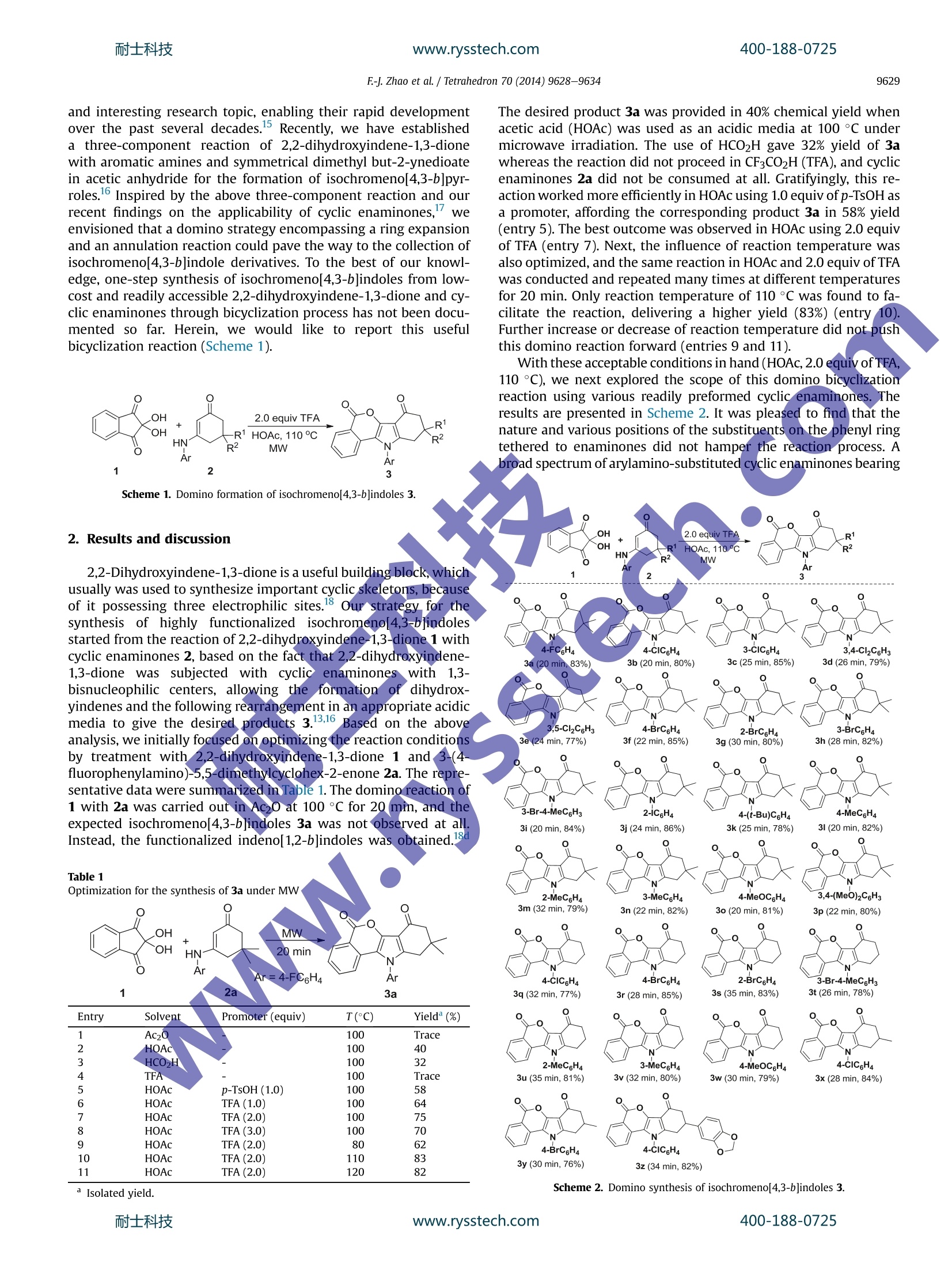
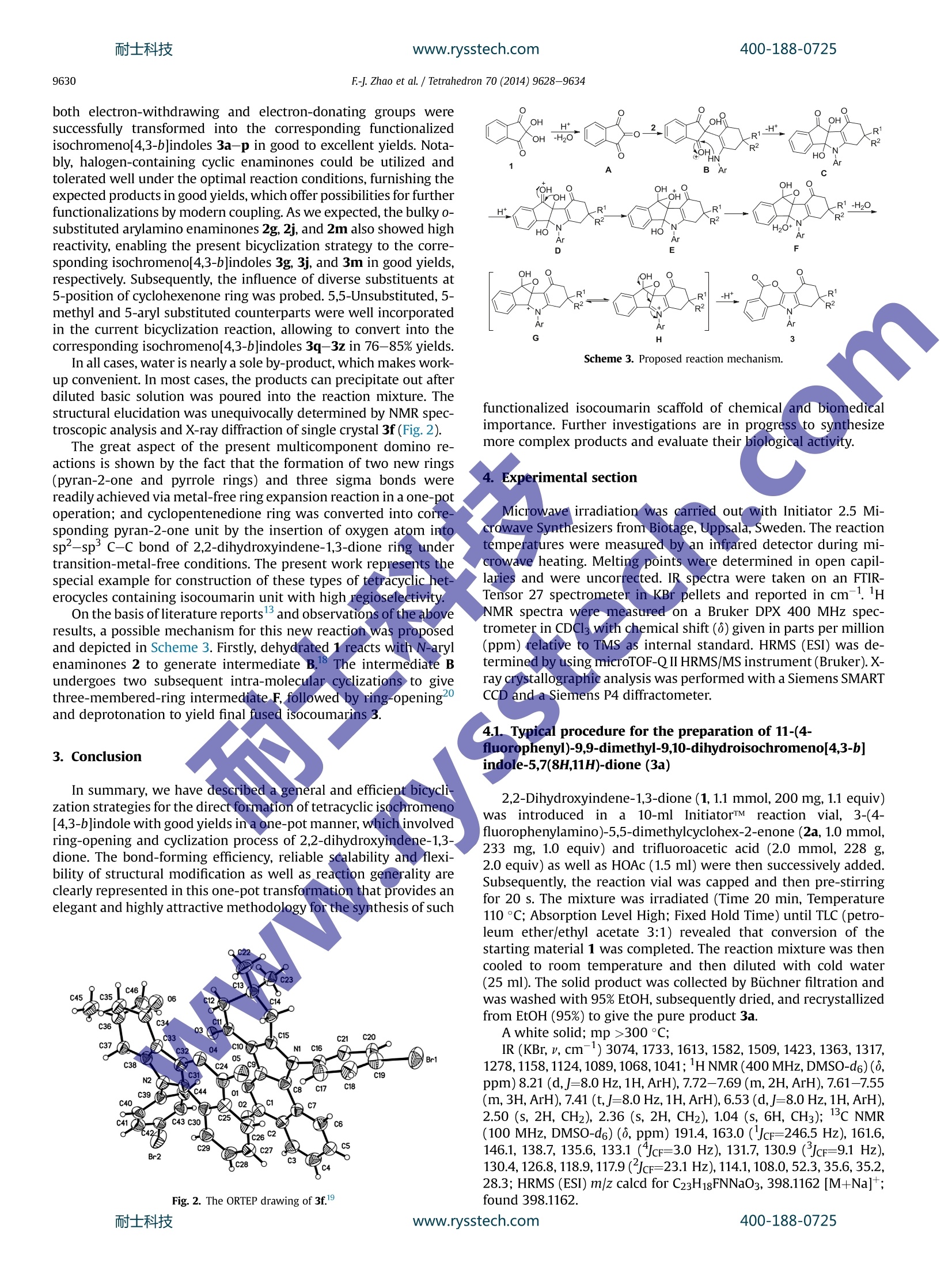
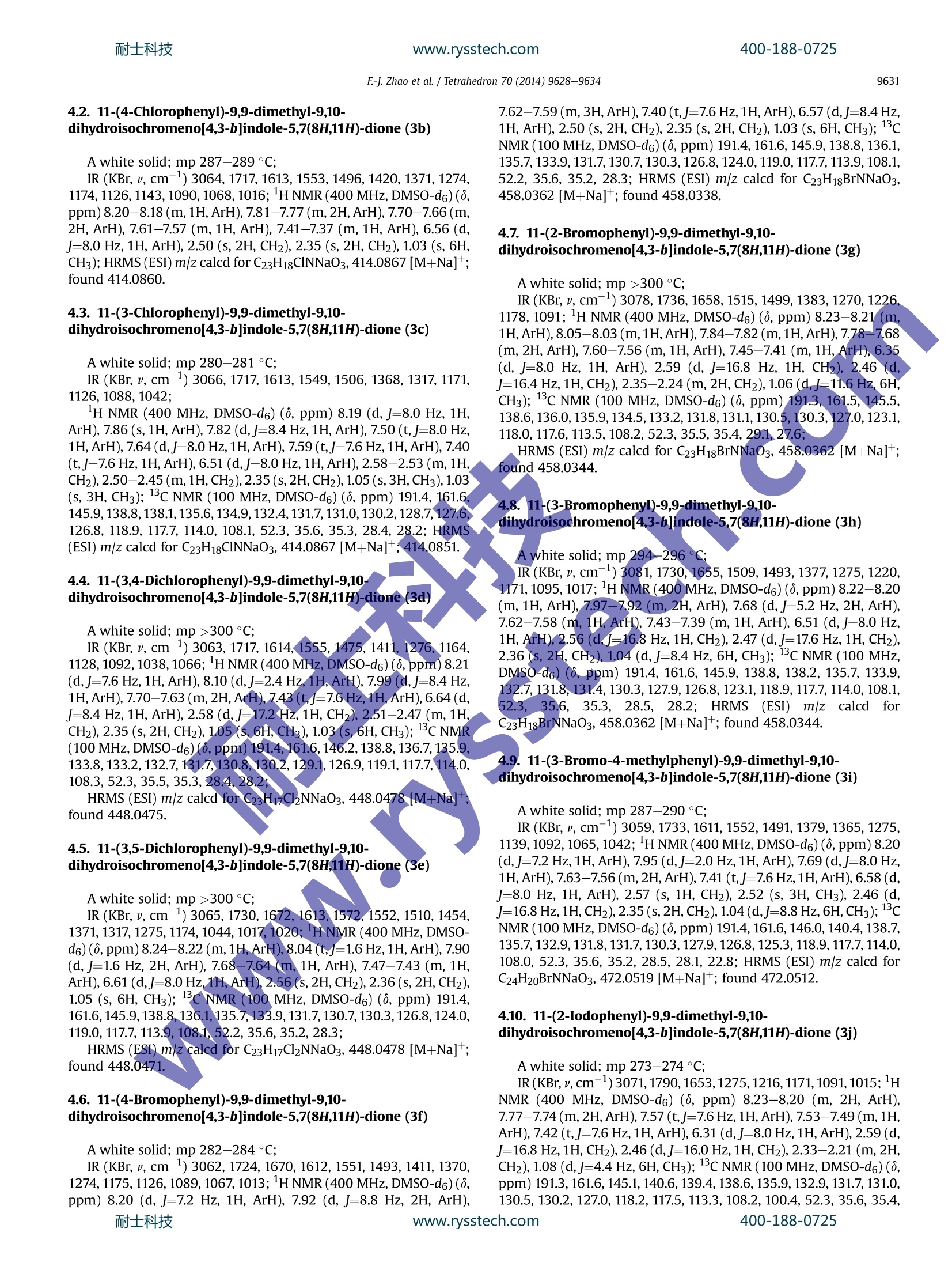
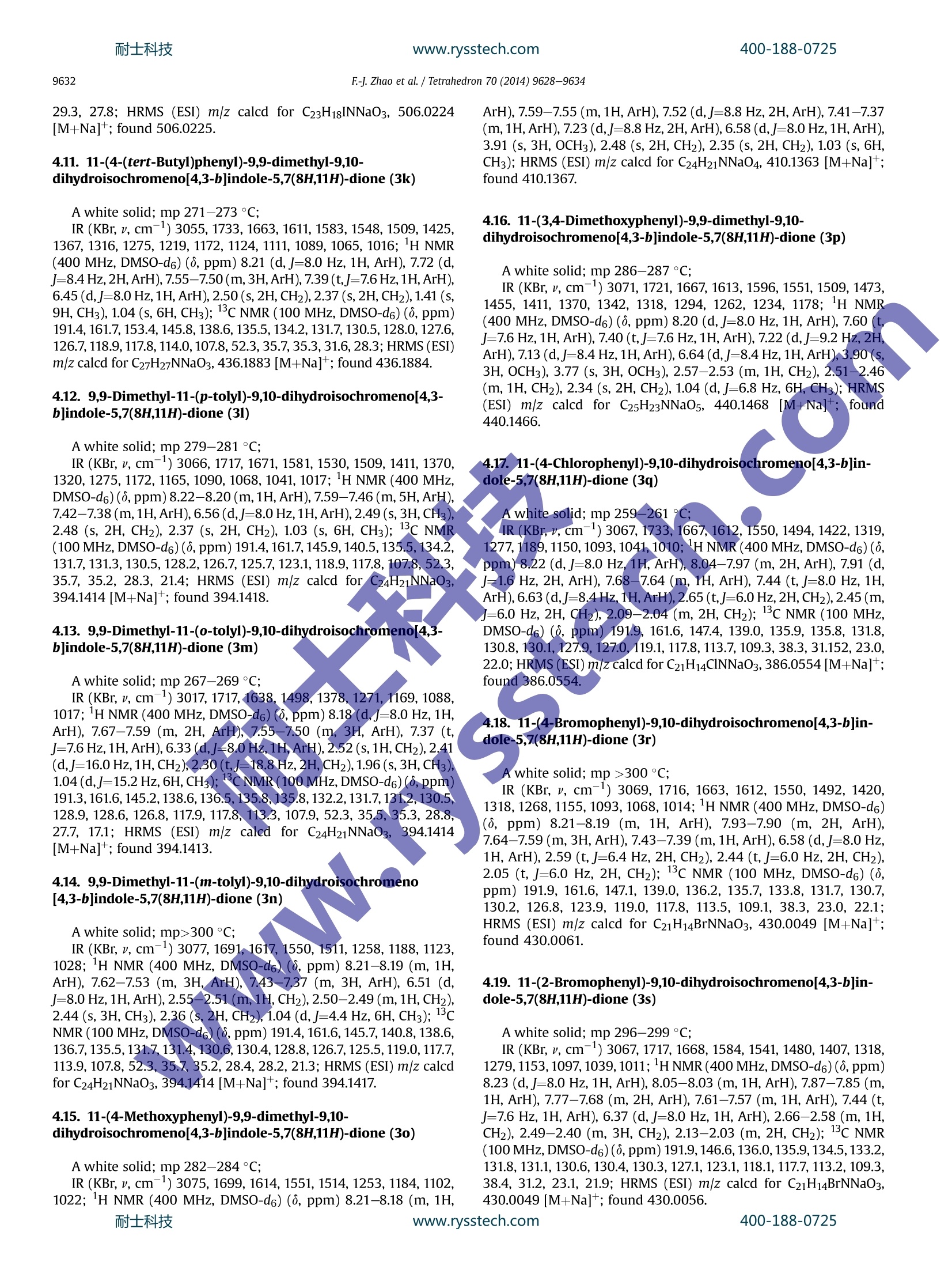
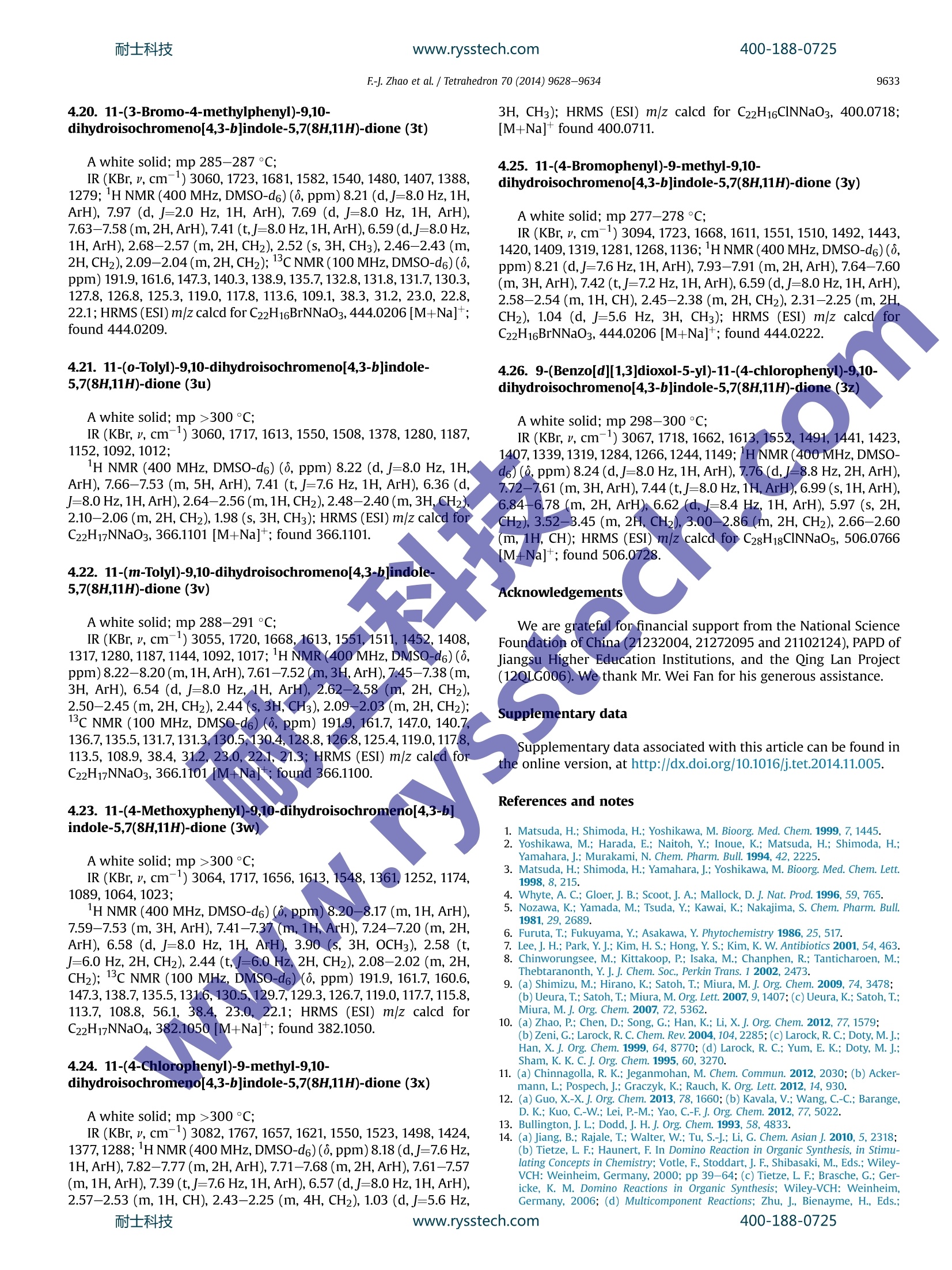

还剩5页未读,是否继续阅读?
上海鑫欣生物科技有限公司为您提供《化学药中注射剂及特殊剂型相关检测方案 》,该方案主要用于化药新药研发中其他检测,参考标准--,《化学药中注射剂及特殊剂型相关检测方案 》用到的仪器有
相关方案
更多
该厂商其他方案
更多








